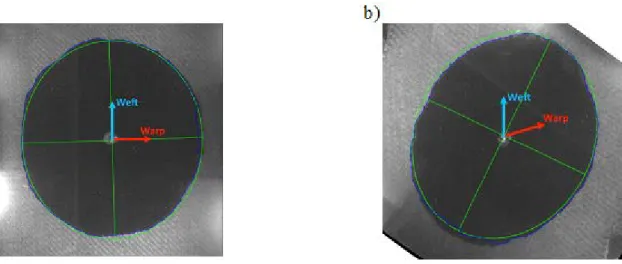HAL Id: hal-02070617
https://hal.archives-ouvertes.fr/hal-02070617
Submitted on 18 Mar 2019
HAL is a multi-disciplinary open access archive for the deposit and dissemination of sci-entific research documents, whether they are pub-lished or not. The documents may come from teaching and research institutions in France or abroad, or from public or private research centers.
L’archive ouverte pluridisciplinaire HAL, est destinée au dépôt et à la diffusion de documents scientifiques de niveau recherche, publiés ou non, émanant des établissements d’enseignement et de recherche français ou étrangers, des laboratoires publics ou privés.
Permeability of sheared woven flax fibres reinforcements;
permeability measurements of the orthotropic behaviour
Pierre-Jacques Liotier, Quentin Govignon, Elinor Swery, Sylvain Drapier,
Simon Bickerton
To cite this version:
Pierre-Jacques Liotier, Quentin Govignon, Elinor Swery, Sylvain Drapier, Simon Bickerton. Perme-ability of sheared woven flax fibres reinforcements; permePerme-ability measurements of the orthotropic be-haviour. 12th International Conference on Flow Processes in Composite Materials, Jul 2014, Twente, Netherlands. �hal-02070617�
PERMEABILITY OF SHEARED WOVEN FLAX
FIBRES REINFORCEMENTS; PERMEABILITY
MEASUREMENTS OF THE ORTHOTROPIC
BEHAVIOUR
Pierre-Jacques Liotier1*, Quentin Govignon2, Elinor Swery2, Sylvain Drapier1,
Simon Bickerton2
1 MPE, Laboratoire George Friedel UMR CNRS 5307, Ecoles des Mines de Etienne, 158 Cours Fauriel 42023
Saint-Etienne, France
2 Centre for Advanced Composite Materials, Department of Mechanical Engineering, University of Auckland, Private Bag
92019, Auckland, New Zealand
3 Université de Toulouse ; Mines Albi, INSA, UPS, ISAE ; ICA (Institut Clément Ader) ; Campus Jarlard, F-81013 Albi,
France
Keywords: Fabrics/textiles; Liquid Composite Molding (LCM); Fabric shear Introduction
With the increased use of Liquid Composite Moulding (LCM) processes in the aeronautical and automotive industries, the complexity of the parts and quality requirements have increased tremendously. The development of fabric forming models and the refinement of mould filling simulations, calls for improved material models to achieve the predictions expected by the industry. Accurate permeability data of reinforcing materials is essential in order to conduct LCM simulations and design the manufacturing process more efficiently [1]. Permeability is predominantly a function of the reinforcement architecture and its fibre volume fraction, both of which are affected by textile deformation when used to manufacture complex 3D parts. The push for more sustainable materials either biodegradable or fully recyclable has also pushed the composite industry to look increasingly at bio-based reinforcements and resins. The bio-based reinforcement being formed from the assembly of short fibrils of variable geometry into continuous strands have very different forming and permeability properties than traditional composite reinforcements formed by assembling continuous fibre with smooth geometry.
This study compares the permeability characteristics of two different flax fibre fabrics with different tow size and a glass fibre fabric with an equivalent tow dimension. In order to gather information on the behaviour of such reinforcements during LCM manufacturing processes, the permeability behaviour of sheared textiles was determined. The fabrics were sheared before conducting the permeability tests, simulating the textile deformation that is present when preforming textiles in 3D moulds and the effects of these deformations on the textile properties were observed.
A set of in-plane permeability experiments were conducted using a 2D radial injection permeability setup where the flow front was optically tracked [2]. The in-plane permeability tensors of the different reinforcing materials were determined for a range of fibre volume fractions and levels of shear applied. A number of semi-empirical models based on these results have thus been developed.
An optical technique for measuring local fibre orientation and shear in the reinforcements was utilised and coupled with the permeability experiments conducted, ensuring that the models obtained reflected the achieved level of shear. The experiments which were conducted at strictly controlled fibre volume fractions showed that the fabric permeability is strongly dependent on the degree of shear of the reinforcements during impregnation [3]. Although it is known that in-plane shear affects the permeability values and anisotropy of a fabric, this study highlights that it also affects the orientation of the permeability tensor relative to the fabric orientation (weft and warp).
Figure 1: Permeability tensor orientation shifting due to shearing of the fabric
References
[1] Walbran, W. A.; Bickerton, S.; Kelly, P. A., Evaluating the shear component of reinforcement compaction stress during liquid composite moulding processes. Journal of Composite Materials. 47(5) 2013 513-528.
[2] Comas-Cardona, S; Cosson, B; Bickerton, S; Binetruy, C, An optically-based inverse method to measure in-plane permeability fields of fibrous reinforcements Compos. Part A 57 (2014) 41-48 .
[3] Verleye B., Croce R., Griebel M., Klitz M., Lomov S.V., Morren G., Sol H., Verpoest I., Roose D., « Permeability of textile reinforcements: Simulation, influence of shear and validation». Compos Sci Technol 68 (2008) 2804– 2810
